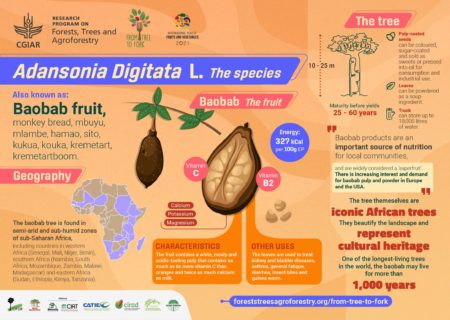- New institute to restore ecosystems, including agricultural ones, gets money.
- Some olive-based ecosystems certainly need restoration, good thing there are genebanks.
- Sometimes, restoring ecosystems means digging up old grapevines and moving them down the road.
The baobab infographic we’ve been waiting for
The International Year of Fruits and Vegetables is as good an excuse as any for another baobab factsheet, and infographic.

Not that an excuse has ever been needed. Anyway, this particular latest example of the genre is courtesy of From Tree to Fork, and the first of many, it seems. No mention of using the fruit to make booze, though.
Nibbles: Seeds, Hazelnut double, Perry pears, Bananas in Puerto Rico
- Save food diversity, chef says.
- All well and good, but Nutella is driving hazelnut monoculture in Italy.
- Let them make wood vinegar!
- No doubt perry pears will be next for the monoculture treatment.
- Bananas are way ahead of pears, perry or otherwise.
Nibbles: Apple diversity, Quinoa diversity, Potato diversity, Indian coconut, Mead recipe
- The need to diversify apple breeding.
- Unlikely pean to the world quinoa core collection. I believe we may have blogged about it.
- And the Commonwealth Potato Collection rounds off today’s trifecta of cool genebanks.
- Kerala’s coconut problems only start with root wilt. Aren’t there coconut collections that could be used to solve them? Well of course there are.
- Recreating bochet, a medieval mead, sounds really hard, but worth it. Someone want to start a mead collection?
Brainfood: Diversification, Diverse diet, Urban forests, Local seed systems, Heterosis, Oil palm core, Black Sigatoka resistance, Pearl millet diversity, Alfalfa diversity, Barley evaluation x2, Ganja origins, Apple origins, Millet diversity, Pepper diversity, Grapevine domestication, Vanilla diversity
- A global database of diversified farming effects on biodiversity and yield. Always good to have the data.
- Dietary agrobiodiversity for improved nutrition and health outcomes within a transitioning indigenous Solomon Island food system. Maybe we should have a database of diversified farming effects on health and nutrition too?
- Exploring ‘beyond-food’ opportunities for biocultural conservation in urban forest gardens. Always good to have more trees.
- Community seed network in an era of climate change: dynamics of maize diversity in Yucatán, Mexico. Always good to have landraces. And neighbours.
- Microbe-dependent heterosis in maize. Maize hybrids need microbes.
- Assessment of genetic diversity and population structure of oil palm (Elaeis guineensis Jacq.) field genebank: A step towards molecular-assisted germplasm conservation. 30% seems a lot for a core collection. But it’s good to have the data.
- Sources of resistance to Pseudocercospora fijiensis, the cause of black Sigatoka in banana. 11 resistant accessions out of 95 seems pretty good, on the other hand.
- GWAS unveils features between early- and late-flowering pearl millets. Based on a national-level core collection in Senegal. Presumably this will scale?
- Germplasm Collection, Genetic Resources, and Gene Pools in Alfalfa. Lots of work has been done. More work is needed on the wild relatives though.
- Assessment and modeling using machine learning of resistance to scald (Rhynchosporium commune) in two specific barley genetic resources subsets. Fancy maths helps to identify the barley genebank accessions you really need.
- Strategic malting barley improvement for craft brewers through consumer sensory evaluation of malt and beer. More fancy maths, this time applied to a hedonic data in the service of beer. Germplasm evaluation we can all get behind. No FIGS, alas.
- Large-scale whole-genome resequencing unravels the domestication history of Cannabis sativa. 4 genetic groups: primordial (located in China, not Central Asia, and going back 12,000 years), 2 medicinal, 1 fibre. Now for the hedonic evaluation.
- The Origins of the Apple in Central Asia. Probably domesticated to cope with the munchies.
- Genetic Divergence and Population Structure in Weedy and Cultivated Broomcorn Millets (Panicum miliaceum L.) Revealed by Specific-Locus Amplified Fragment Sequencing (SLAF-Seq). There are interesting genetic differences between wild and feral forms, and between eastern and central-western cultivated forms. The Silk Road trifecta.
- Global range expansion history of pepper (Capsicum spp.) revealed by over 10,000 genebank accessions. Spoke too soon. The Silk Road had a role in pepper movement too. Among other trade routes. Interesting, and unsurprising, that genes for pungency show distinct geographic patterns.
- Genomic evidence supports an independent history of Levantine and Eurasian grapevines. First domestication in the Caucasus, and then in the Levant, but not clear if from local sources. No word on hedonic evaluation.
- Genotyping-By-Sequencing diversity analysis of international Vanilla collections uncovers hidden diversity and enables plant improvement. Belize seems to be a real hotspot. The Silk Road not involved.